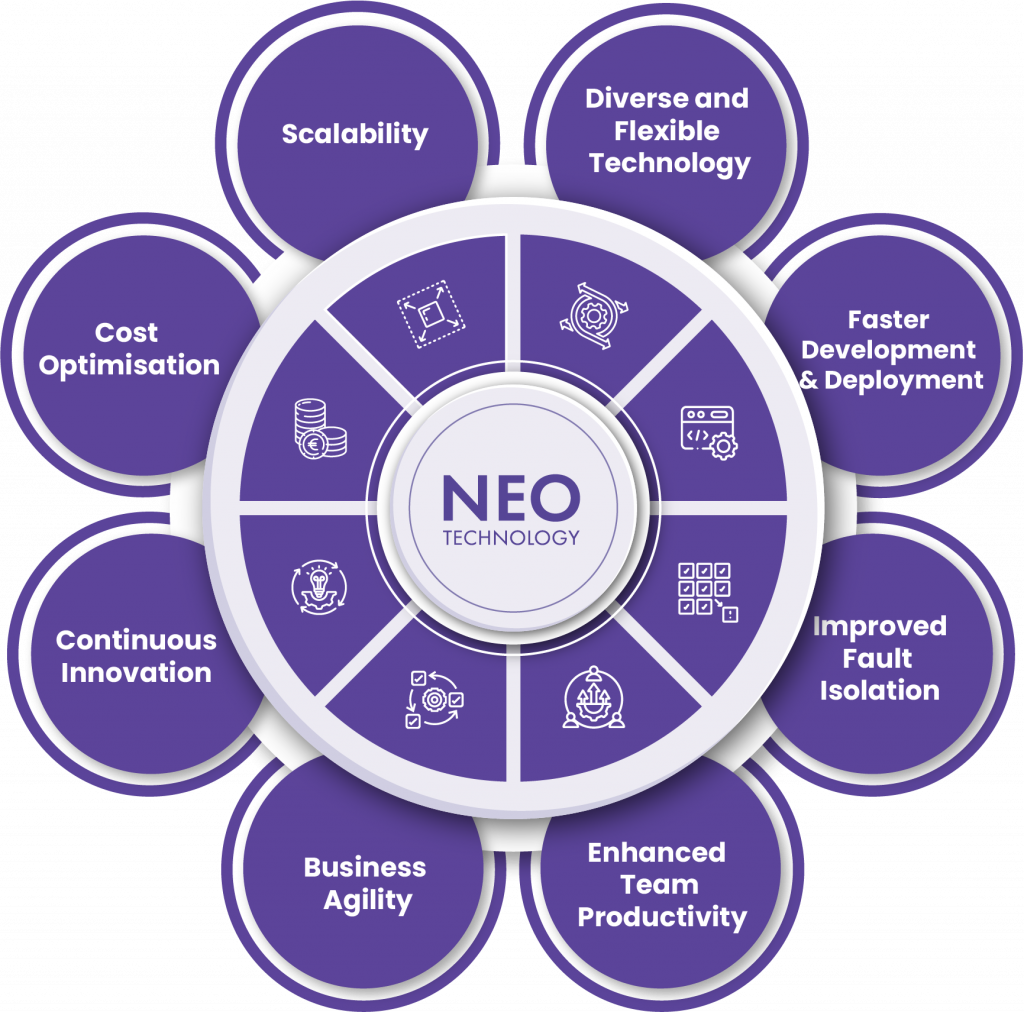
Introduction
Microservices computing has emerged as a transformative approach to software development, revolutionising how modern applications are designed, built, and deployed. In this eBook, we will delve deeper and explore the process of integrating and migrating to best-of-breed solutions and highlight the numerous benefits that organisations can achieve by adopting microservices in their computing strategies.
The Core benefits of
Microservices
Microservices are small, independent, and loosely coupled applications that are usually in use already. A single small team of developers can integrate, write, and maintain these services.
Services can be deployed independently, allowing customers to interchange best-of-breed applications. A team can update an existing service without rebuilding and redeploying the entire application.
Each service is a separate codebase, which can be managed by a small development team.
Services are responsible for persisting their own data which is usually pushed via API to a Data Lake in the cloud. This differs from the traditional model, where a separate data layer
handles each data persistence.
Services communicate with each other by using well-defined APIs. Internal implementation details of each service are hidden from other
services and are surfaced through a single view web portal.
Services don’t need to share the same technology stack, libraries, or frameworks.
Microservices Architecture
The fundamental principles that define the microservices architecture provide a solid foundation for building scalable and flexible applications:
Routine updates will ensure that your backlog reflects the progress of the team and adapts to meet their Sprint Goal. This will help team members to adjust their priorities and targets accordingly. It is important that Scrum teams invite as many people to participate as possible – diverse feedback is essential for making progress.
In microservices computing, each service maintains its own database, emphasising the importance of bounded contexts in domain-driven design. By decentralising data management, microservices avoid creating monolithic databases that introduce data coupling and complexity. Each microservice focuses solely on managing data related to its specific functionality, reducing the risk of data corruption and enabling data consistency and integrity across the system.
Microservices communicate with one another through well-defined APIs, typically using lightweight protocols such as HTTP or REST. This simplicity in communication fosters technological diversity, allowing teams to choose the most suitable programming languages, frameworks, and technologies for each service. It also facilitates seamless integration with other services and external systems, promoting modularity and flexibility.
The microservices architecture embraces continuous integration and deployment, empowering organisations to automate the software delivery pipeline. Each microservice can have its own CI/CD pipeline, enabling rapid and reliable deployment of changes. Automated testing and continuous delivery practices ensure that updates are thoroughly tested and readily available for deployment, reducing the time between development and production releases.
Steps to Implement
Microservices Solutions
Application Analysis and Domain Decomposition
Service Identification and API Definition
Data Management Strategy
Integration Middleware
Scalability and Load Balancing
Security and Authentication
Monitoring and Observability
Testing and Quality Assurance
Cultural Shift and Team Organisation
Benefits of Integrated
Microservices In Computing
The adoption of microservices offers a wide range of benefits for organisations striving for agility and efficiency:

Scalability
Diverse and Flexible Technology
Enhanced Team Productivity
Business Agility
Faster Development and Deployment
Improved Fault Isolation
Continuous Innovation
Cost Optimisation

Conclusion
Microservices computing represents a paradigm shift in software development, offering numerous advantages for organisations seeking to stay competitive in a fast-paced digital landscape. The architecture of microservices, with its emphasis on service independence, lightweight communication, and continuous integration, empowers organisations to build flexible, scalable, and resilient applications. Successfully implementing microservices requires careful planning, a cultural shift, and an investment in modern development practices. By embracing microservices computing and integrating best-of-breed solutions, organisations can achieve a higher level of agility, innovation, and efficiency, ultimately driving greater success in today’s technology-driven world.